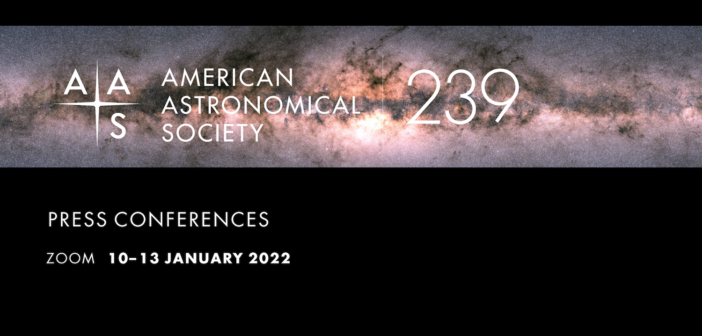Although we’re no longer gathering in person in Salt Lake City for AAS 239, we’ll still be showcasing exciting new research results in our virtual press program! Press conferences will take place at 10:15 am and 2:15 pm MST (17:15 and 21:15 UTC/GMT) on 10, 12, and 13 January, and at 12:15 pm and 2:15 pm MST (19:15 and 21:15 UTC/GMT) on 11 January.
All press conferences will be viewable live on the AAS Press Office YouTube channel at the times listed below. Can’t make it? Recordings will be uploaded to YouTube and summaries of each day’s press proceedings written by a team of Astrobites authors will be posted here and on astrobites.org. We hope to see you there!
In addition to the press conferences, the NASA Astrophysics Town Hall, the National Science Foundation Division of Astronomical Sciences Town Hall, various Stratospheric Observatory for Infrared Astronomy (SOFIA) science talks and webinars, and other programming will be proceeding as planned. You can find the schedule for these events and instructions for joining virtually here.
Press Conference Schedule
Monday, 10 January 2022, 10:15 am MST
Galaxies & Quasars
A Map of the Molecular Ring and Arms of a Spiral Galaxy
Jessica Sutter (Stratospheric Observatory for Infrared Astronomy)
A Multiwavelength View of IC 860: What Is in Action Inside Quenching Galaxies?
Yuanze Luo (Johns Hopkins University)
Uncovering a Hidden Mini-Monster: A Heavily Obscured Active Galactic Nucleus in a Dwarf Star-Forming Galaxy
Ryan Hickox (Dartmouth College)
A New Population of Supermassive Black Holes in Dwarf Galaxies
Mallory Molina (Montana State University)
Monday, 10 January 2022, 2:15 pm MST
Black Holes & Transient Phenomena
NASA’s Newest X-Ray Eyes: An Update on the Imaging X-ray Polarimetry Explorer (IXPE)
Martin C. Weisskopf (NASA Marshall Space Flight Center)
Tidal Disruption Events in the Very Large Array Sky Survey
Vikram Ravi & Jean Somalwar (California Institute of Technology)
The Most X-Ray Luminous Fast Blue Optical Transient
Yuhan Yao (California Institute of Technology)
Tuesday, 11 January 2022, 12:15 pm MST
SDSS: Passing the Torch to Phase 5
Almost a Million Stars and Counting: Mapping the History of the Milky Way with APOGEE and Beyond
Rachael Beaton (Princeton University)
Galaxies, Assemble: MaNGA Team Releases Largest-Ever Collection of 3D Maps of Nearby Galaxies
Karen Masters (Haverford College)
SDSS-V Robots See First Light
Juna Kollmeier (Canadian Institute for Theoretical Astrophysics, University of Toronto)
Tuesday, 11 January 2022, 2:15 pm MST
Stellar Nurseries, Clusters & Streams
A New Window on Star Formation History at the Galactic Center
Zhuo Chen (University of California, Los Angeles)
Giant Molecular Clouds: Storytellers of the Galactic Center’s History in the Past Few Hundred Years
Shuo Zhang (Bard College)
Identifying Hidden Globular Clusters in the Centaurus A Galaxy
Allison Hughes (University of Arizona)
Twelve for Dinner: The Milky Way’s Feeding Habits Shine a Light on Dark Matter
Ting Li (University of Toronto)
Wednesday, 12 January 2022, 10:15 am MST
Evolving Stars & Their Activity
Detection of White Dwarf Companions to Blue Lurkers in Star Cluster M67
Andrew Nine (University of Wisconsin-Madison)
A Unique Gamma-Ray-Bright Neutron Star Binary with an Extremely Low Mass Proto-White Dwarf
Samuel Swihart (Naval Research Laboratory)
Discovery of Extreme Superflares on the Recurrent Nova V2487 Ophiuchi
Bradley Schaefer (Louisiana State University, Baton Rouge)
Wednesday, 12 January 2022, 2:15 pm MST
Mapping Local Structure & More Evolving Stars
1,000-Light-Year-Wide Bubble Surrounding Earth is Source of All Nearby, Young Stars
Catherine Zucker (Space Telescope Science Institute & Center for Astrophysics | Harvard & Smithsonian)
Mapping the Interstellar Medium in Our Rear-View Mirror: The Million Year History of the Heliosphere
Seth Redfield (Wesleyan University)
Wolf-Rayet Stars Exploding as Supernovae
Avishay Gal-Yam (Weizmann Institute of Science)
The Fates of Wolf-Rayet Stars, the Strangest Supernovae, and the Origins of Massive Black Holes
Daniel Perley (Liverpool John Moores University)
Thursday, 13 January 2022, 10:15 am MST
Exoplanets & Their Atmospheres
Revealing the Stormy, Turbulent Nature of Giant Exoplanet Analogs
Johanna Vos (American Museum of Natural History)
Observing Seasons on a Migrating Giant Exoplanet with the Retired Spitzer Space Telescope
Lisa Dang (McGill University)
The Hottest Jupiters Orbiting Evolved Stars
Samuel Grunblatt (American Museum of Natural History / Flatiron Institute)
A Mirage or an Oasis? A Tentative Detection of Water Vapor in an Exoplanet Atmosphere
Jonathan Brande & Ian Crossfield (University of Kansas)
Discovery of Debris Disks in Kepler Habitable Small Planet Candidates
Amanda Hao (Aragon High School) & Jian Ge (Shanghai Astronomical Observatory, Chinese Academy of Sciences)
Thursday, 13 January 2022, 2:15 pm MST
Intriguing Stars & Citizen Discoveries
Betelgeuse, the Great Dimming: Before and After
Andrea Dupree (Center for Astrophysics | Harvard & Smithsonian)
Living with a Red Dwarf: Improved Relationships for M Dwarfs
Scott Engle (Villanova University)
Discovery of a TESS Giant Planet on a 261-Day Orbit Enabled by Citizen Science
Paul Dalba (University of California Riverside)
Discovery of the Widest Known Brown Dwarf Binary
Emma Softich (Arizona State University) & Adam Schneider (United States Naval Observatory, Flagstaff Station; George Mason University)
Galaxy Zoo Clump Scout: Surveying the Local Universe for Giant Star-Forming Clumps
Nico Adams (University of Minnesota, Twin Cities)

